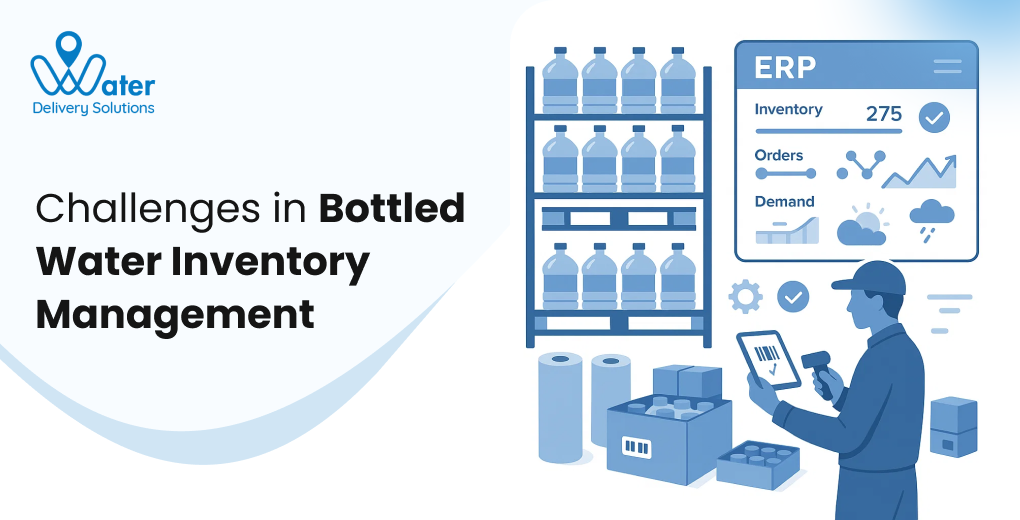
Inventory in the bottled water business includes empty and filled water bottles, bottle caps, and labeling and packing material. ERP for bottled water inventory management is an integrated system that automates and streamlines entire business operations, including inventory management.
With the increasing demand for clean and healthy drinking water, bottled water has become paramount, making efficiency a major aspect of bottled water businesses. However, with changing weather-driven seasonal demands to reduce the volume and storage requirements, businesses face difficulty managing their inventory.
Water Delivery Solutions (WDS) offers ERP solutions for bottled water manufacturing and distribution businesses to automate and streamline your production, procurement, quality control, finances, inventory, and distribution. This blog will examine the potential inventory challenges faced by bottled water businesses.
Inventory challenges faced by businesses without a bottled water ERP
Bottled water manufacturing and distribution businesses face unique inventory challenges that require advanced tools to handle. Manual inventory management is prone to human errors, which reduces efficiency, productivity, and ultimately profits. An ERP for bottled water inventory management can help you handle these challenges, ensuring optimal stock levels and timely order fulfillment. The major inventory challenges faced by bottled water businesses without an ERP system are:
Inaccurate data and tracking
Manual inventory management involves counting stock, maintaining paper records, and purchasing stock on a call or one-on-one. Manual data and tracking can lead to:
- Relying on manual processes or legacy systems can lead to inventory mismatches between the recorded and actual inventory counts.
- Counting errors, data entry mistakes, and a lack of real-time inventory tracking.
- Inaccurate inventory data leads to stockouts and overstocking.
- Incorrect data makes it challenging to track products, manage recalls, and understand true inventory levels across multiple warehouses.
- Manual bottled water tracking is prone to errors, leading to Lost and damaged bottles and increasing complexities.
An ERP for the bottled water business integrates all business operations with data flow automation, ensuring inventory precision and streamlining operations.
Overstocking or understocking
Overstocking/understocking refers to having too much or too little inventory in the warehouse to meet demand, resulting in inefficiencies and financial losses. Overstocking/understocking can:
- Hold your capital, increase storage costs, elevate the risk of damage or obsolescence (water doesn’t expire; however, the plastic bottles degrade), and waste storage.
- Lost sales, customer dissatisfaction, potential damage to brand reputation, and increased replenishment costs for faster shipping.
- Demand changes due to seasonal changes, weather conditions, and local events can imbalance your stock levels.
ERP provides real-time stock updates and automated replenishment, enabling you to monitor stock levels and ensure optimal stock. You can define an inventory threshold to automate replenishment, preventing stockouts and overselling.
Limited inventory visibility
Lacking real-time inventory insights, location, and movement across the water delivery supply chain makes it difficult to know accurate stock availability. It hinders:
- Makes effective inventory planning impossible, delaying order fulfillment, complicating demand adjustments, and making optimizing inventory challenging.
- Locating where and how much stock is available throughout the supply chain is difficult.
- Leads to stockouts and overstocking, inaccurate forecasting, and lost sales.
The ERP system provides complete visibility of the stock throughout the supply chain, from procurement of raw materials to the final product in the warehouse and delivery to customers.
Inefficient warehouse process
Ineffective warehouse layouts, manual picking and packing, a lack of automation, and poor organization within the warehouse lead to flawed warehouse management. Ineffective warehouse management results in:
- Manual warehouse management can lead to time wastage, higher labor costs, and errors.
- Slow down order fulfillment, reduce overall business efficiency, and increase the risk of product damage.
- Bulk and heavy water bottles need efficient handling and storage solutions. Inefficient processes can lead to supply chain bottlenecks and strain your warehouse staff.
The ERP for bottled water inventory management can help you integrate IoT devices, such as barcode scanners or RFID, to enable bottled water lot/batch tracking within a single or multiple warehouses.
Unreliable demand planning
Relying on outdated forecasting methods, a lack of data analysis, and an inability to account for influencing factors can lead to inaccurate demand calculations. Unreliable demand planning can:
- It can lead to overstocking and understocking.
- Insufficient stock levels lead to lost sales opportunities.
- Having surplus stock can result in wastage and higher storage costs.
- This impacts profits and customer satisfaction.
Bottled water demand is particularly impacted by external factors, making accurate demand planning a significant hurdle. The features of ERP inventory management utilize artificial intelligence and machine learning to forecast demand accurately.
Managing returns and obsolescence
It is challenging to keep track of the number of filled and empty bottles available in the warehouse and with customers in real time. Even though the water doesn’t expire, the plastic bottle can degrade with time, impacting the water. Manually managing returns and obsolescence results in:
- Manual return management is prone to errors and can result in lost bottles and financial losses.
- This can hinder customer experience, leading to increased customer churn rates.
The ERP features provide predictive analysis functionality. It analyzes historical data to identify patterns and trends for accurate demand forecasts.
Managing long-tail spend
Long-tail spending refers to managing the costs associated with low-value, large purchases related to inventory management. It includes managing the procurement of various bottle types, caps, labels, and bottling and packaging machinery maintenance. These purchases may seem small, but they are collectively high. Manually managing long-tail spending can:
- Leads to errors in spending data.
- Budget overruns and reduced profitability.
- Losing bottles and financial losses.
You can manage all your expenses with an ERP for bottled water services. The system enables you to track, monitor, and control business expenses.
Conclusion
These are some common challenges that bottled water businesses face without an adequate system to automate and streamline inventory management operations. Water Delivery Solutions (WDS) offers an ERP for bottled water businesses that can optimize inventory operations, ensuring optimal stock levels and timely order fulfillment.
Are you curious to know more about ERP? Schedule a free demo with our team to see how it works and help your business.

He loves to explore. His passion for helping delivery industries in all aspects flows through in the vision he has. In addition to providing smart solution to make delivery process flawless, Ravi also likes to write sometimes to make it easier for people from business industry looking for digital solutions.

